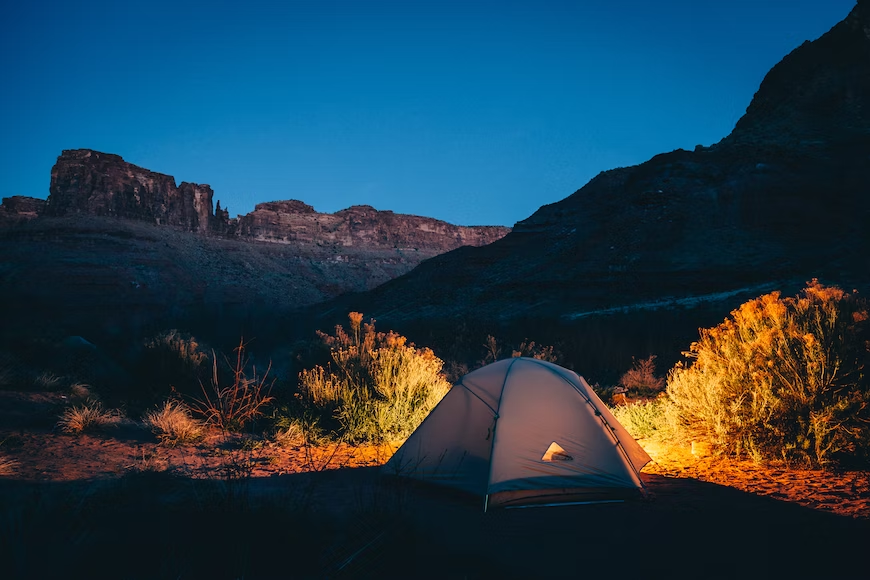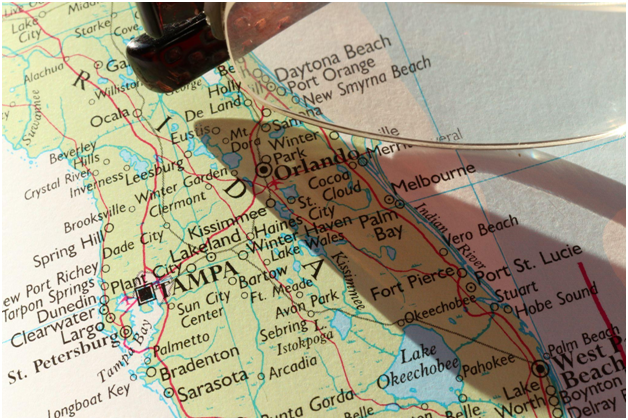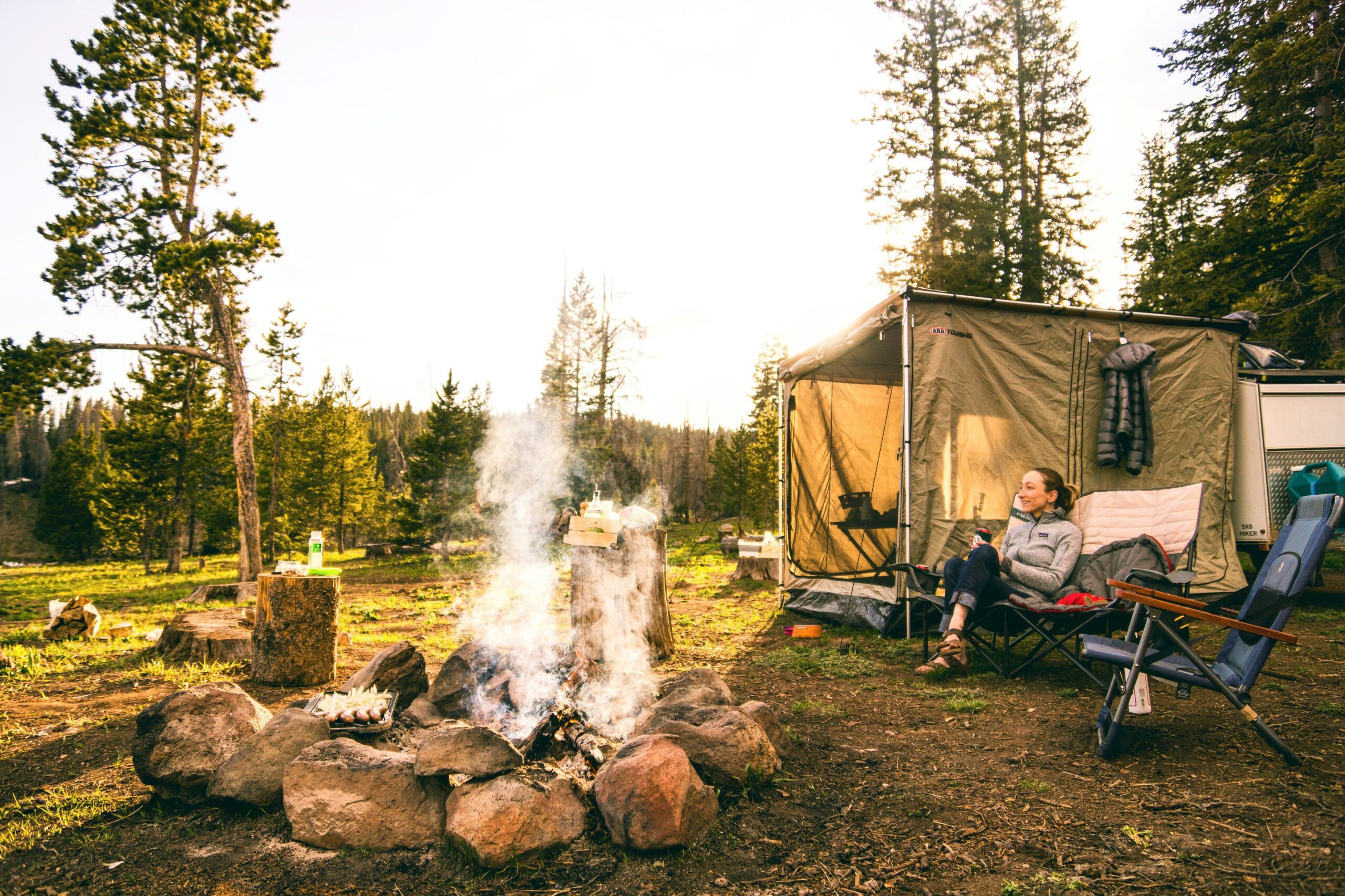Introduction:
Camping is a beloved activity that allows people to reconnect with nature, unwind from the daily grind, and create lasting memories. Whether you’re an experienced camper or new to the world of outdoor adventures, ensuring your safety and survival should always be a top priority. In this article, we will explore essential camping safety tips, wilderness survival skills, first aid and emergency preparedness, navigation and orientation techniques, campfire safety, weather awareness and preparedness, wildlife safety, equipment maintenance and inspection, leave-no-trace principles, and communication and emergency signaling. Let’s embark on this journey together, as we delve into the world of camping safety and survival.

Camping Safety and Survival Tips: Essential Safety Guidelines for Camping
Camping is an exciting and enjoyable activity, but it’s essential to prioritize safety to have a memorable experience. Here are some important safety guidelines to follow when camping:
-
Be Prepared and Plan Ahead
Before heading out on your camping trip, thorough preparation and planning are crucial. Research the location, familiarize yourself with the surroundings, and understand any potential risks or hazards.
-
Pack the Right Gear and Equipment
Having the right camping gear and equipment can make a significant difference in your safety and comfort. Ensure you have essential items such as a tent, sleeping bag, appropriate clothing, first aid kit, flashlight, and extra food and water.
- Inform Others About Your Plans
Always let someone know about your Camping Safety and Survival plans, including the location, duration of your stay, and when you expect to return. In case of an emergency, this information can be vital for rescue operations.
-
Set Up Camp Safely
When setting up your campsite, choose a location away from hazards such as dead trees, steep slopes, or areas prone to flooding. Clear the area of debris and ensure your tent is properly secured to withstand wind and rain.
-
Stay Hydrated and Well-Nourished
Proper hydration and nutrition are essential for your overall well-being while Camping Safety and Survival. Drink plenty of water, eat nutritious meals, and avoid consuming food that may spoil easily.
-
Practice Fire Safety
If you plan to have a campfire, ensure you follow the established guidelines and regulations for the area. Keep the fire in a designated fire ring or pit, never leave it unattended, and fully extinguish it before leaving the campsite or going to sleep.
-
Respect Wildlife and Nature
When camping, it’s crucial to respect the local wildlife and nature. Keep a safe distance from animals, refrain from feeding them, and properly store your food to avoid attracting unwanted visitors.
Wilderness Survival Skills: Learning Essential Survival Techniques for Camping
While Camping Safety and Survival, you may find yourself in unexpected situations that require wilderness survival skills. Being prepared with the knowledge and techniques can make all the difference. Here are some essential wilderness survival skills to learn:

-
Finding and Purifying Water
Water is essential for survival, and knowing how to find and purify water sources is crucial. Learn how to identify potential water sources in the wilderness and use purification methods such as boiling, filtering, or using water purification tablets.
-
Building a Shelter
In case your tent becomes unusable or you need temporary shelter, knowing how to build a makeshift shelter using natural materials can provide protection from the elements. Learn different shelter-building techniques based on your surroundings and available resources.
-
Navigation Without Modern Technology
Navigating in the wilderness without relying on modern technology is a valuable skill. Learn how to use a compass, read maps, and identify natural landmarks to find your way. Familiarize yourself with basic orienteering skills and practice them before your Camping Safety and Survival trip.
-
Starting a Fire
Fire can provide warmth, a means to cook food, and a way to signal for help if needed. Learn various fire-starting techniques, such as using a fire starter, flint and steel, or friction methods like the bow drill or hand drill.
-
Obtaining and Preparing Food
While Camping Safety and Survival, you may need to obtain food from the wilderness. Familiarize yourself with edible plants, berries, and mushrooms in the area, and learn how to safely forage and prepare them. Additionally, understanding basic hunting and fishing techniques can be valuable survival skills.
-
Dealing with Medical Emergencies
In the wilderness, medical emergencies can happen. Knowing how to handle common camping injuries, such as cuts, burns, sprains, or insect bites, is crucial. Take a first aid course and pack a comprehensive first aid kit tailored to your camping needs.
-
Creating Signaling Devices
If you find yourself in an emergency situation and in need of rescue, having signaling devices can greatly increase your chances of being found. Learn how to create and use signaling devices such as whistles, signal mirrors, or improvised signal fires.
First Aid and Emergency Preparedness: Handling Common Camping Injuries and Illnesses
While Camping Safety and Survival, it’s essential to be prepared for medical emergencies and know how to handle common injuries and illnesses that can occur outdoors. Here are some first aid tips for camping trips:

-
Basic First Aid Skills
Having basic first aid skills can be invaluable in a camping setting. Learn how to properly clean and dress wounds, perform CPR, provide relief for burns and insect bites, and recognize the symptoms of common illnesses.
-
Creating a Camping Emergency Kit
Prepare a camping emergency kit that includes essential medical supplies. It should contain items such as bandages, adhesive tape, antiseptic wipes, pain relievers, insect repellent, sunscreen, and any necessary personal medications. Keep the kit easily accessible and ensure everyone in your camping group knows its location.
-
Handling Common Camping Injuries
While camping, injuries can occur, ranging from minor cuts and bruises to more severe conditions. Be prepared to handle common camping injuries such as sprains, strains, blisters, burns, and cuts. Properly clean and dress wounds, immobilize sprained or fractured limbs, and seek medical help if necessary.
-
Recognizing and Treating Illnesses
Being aware of common camping-related illnesses can help you identify symptoms and provide appropriate care. Learn to recognize conditions such as heat exhaustion, dehydration, food poisoning, allergic reactions, and hypothermia. Carry necessary medications and seek medical attention if symptoms worsen.
Navigation and Orientation: Navigating in the Wilderness During Camping
Navigating in the wilderness can be challenging, especially if you’re unfamiliar with the area. Here are some basic orienteering skills and techniques to help you navigate with confidence:
-
Using a Compass
A compass is an essential tool for navigation in the wilderness. Learn how to use a compass to determine directions, read maps, and orient yourself to your surroundings. Practice using a compass in different environments and become comfortable with its functionalities.
-
Reading Maps
Reading maps is a fundamental skill for wilderness navigation. Familiarize yourself with topographic maps, understand symbols and contour lines, and learn how to plot your location, measure distances, and identify key landmarks. Practice reading maps to improve your proficiency.
Understanding Landmarks and Navigation Aids
Nature provides various landmarks and navigation aids that can help you find your way. Learn to identify natural features such as mountains, rivers, rock formations, and distinct trees. Utilize these landmarks in conjunction with your map and compass for accurate navigation.
-
Using GPS and Navigation Apps
While traditional navigation skills are crucial, technology can also aid your wilderness navigation. Familiarize yourself with GPS devices and navigation apps designed for outdoor activities. However, always have a backup plan and carry physical maps and a compass in case of technology failures or battery depletion.
Campfire Safety: Campfire Guidelines and Responsible Fire Management
Campfires are an integral part of the camping experience, providing warmth, cooking facilities, and a cozy ambiance. However, it’s essential to follow campfire safety guidelines and practice responsible fire management. Here are some tips for campfire safety:
-
Check Local Regulations and Fire Bans
Before starting a campfire, check with the local authorities or campsite management for any fire bans, restrictions, or specific regulations. Some areas may prohibit campfires during dry seasons or high fire risk periods.
-
Choose a Safe Location
Select a safe location for your campfire. Ensure it’s a designated fire ring or pit and positioned away from flammable materials such as dry grass, overhanging branches, or tents. Clear the area from debris and maintain a safe distance from your campsite.
-
Gather Proper Firewood
Use only local and sustainable firewood sources. Avoid cutting live trees or branches, as they contribute to the natural ecosystem. Gather dead and fallen wood from the ground, ensuring it’s dry and free from moisture.
-
Build and Maintain a Controlled Fire
When building a campfire, start small and gradually add more wood as needed. Keep the fire at a manageable size and never leave it unattended. Avoid building excessively large fires that can become uncontrollable and pose a safety hazard.
-
Extinguish the Fire Properly
Before leaving your campsite or going to sleep, extinguish the campfire completely. Pour water over the fire, ensuring all embers are extinguished. Stir the ashes to cool them down and feel for any remaining heat. Repeat the process until the fire is fully extinguished.

-
Preventing Wildfires
Preventing wildfires is everyone’s responsibility. Be cautious with fire-related activities, avoid throwing cigarette butts on the ground, and report any signs of wildfires immediately. Respect fire bans and follow local guidelines to minimize the risk of wildfires.
Weather Awareness and Preparedness: Camping in Various Weather Conditions Safely
Weather conditions can significantly impact your camping experience and safety. Being aware of weather patterns and adequately prepared for different conditions is essential. Here’s how to stay safe in various weather conditions while camping:
-
Understanding Weather Forecasts
Check weather forecasts for your camping area before and during your trip. Pay attention to temperature, precipitation, wind speed, and any severe weather alerts. Understand how these conditions can affect your camping activities and plan accordingly.
-
Packing Appropriate Clothing and Gear
Pack clothing suitable for a range of weather conditions. Include layers that can be added or removed to regulate body temperature. Ensure you have waterproof and windproof outer layers, as well as appropriate footwear for various terrains.
-
Setting Up a Secure Campsite
In windy conditions, properly secure your tent and other equipment to prevent damage or accidents. Use guy lines, stakes, and additional tie-downs to ensure stability. Avoid setting up camp in low-lying areas prone to flooding during heavy rainfall.
-
Sheltering from Extreme Weather
In case of severe weather conditions, such as thunderstorms, heavy rain, or high winds, seek appropriate shelter. If available, use designated camping shelters, cabins, or vehicles. Avoid taking shelter under tall trees or near bodies of water during lightning storms.
-
Recognizing Signs of Hypothermia and Heat-related Illnesses
Extreme temperatures can lead to hypothermia or heat-related illnesses. Learn to recognize the signs of these conditions, such as shivering, confusion, dizziness, or nausea. Take appropriate measures to prevent or treat these conditions, such as adding layers or seeking shade and hydration.
-
Evacuating During Severe Weather Events
In the event of severe weather warnings or natural disasters, follow the instructions and guidance provided by local authorities. Be prepared to evacuate if necessary and have an emergency plan in place. Ensure you have essential supplies and necessary documents readily available.
Wildlife Safety and Encounters: Staying Safe in Areas with Wildlife
Camping often takes you into natural habitats shared by various wildlife species. Respecting wildlife and understanding how to stay safe in their presence is crucial. Here are some tips for wildlife safety and minimizing encounters:
-
Research Local Wildlife and Behavior
Before your camping trip, research the local wildlife in the area you’ll be visiting. Understand their habits, behavior, and any potential risks they may pose. This knowledge will help you know what to expect and how to act appropriately.
-
Store Food Properly
Proper food storage is essential to minimize wildlife encounters. Use bear-resistant containers or hang food bags high off the ground between trees, away from your campsite. Dispose of food waste properly and follow Leave-No-Trace principles.
-
Avoid Feeding Wildlife
Feeding wildlife is dangerous and harmful to their natural behavior. Never attempt to feed or attract animals to your campsite, as it can create dependency and potentially dangerous situations. Observe wildlife from a safe distance and appreciate them in their natural habitat.
-
Maintain a Clean Campsite
Keep your campsite clean and free from food debris that may attract wildlife. Dispose of trash in designated containers or pack it out with you. A clean campsite reduces the likelihood of wildlife encounters and helps preserve the natural environment.
-
Be Alert and Make Noise
When hiking or moving around in wildlife habitats, be alert and make noise to alert animals of your presence. This reduces the chances of surprising or startling them, minimizing potential conflicts. Carry bear bells or clap your hands periodically to avoid surprising wildlife.
Equipment Maintenance and Inspection: Ensuring Safety Through Proper Gear Care
Your camping equipment plays a crucial role in ensuring your safety and comfort in the outdoors. Regular maintenance and proper gear care are essential. Here’s how to keep your equipment safe and functional:
-
Check Equipment Before Each Trip
Before heading out on a camping trip, inspect all your equipment thoroughly. Check tents for tears or worn-out seams, test stove functionality, and ensure sleeping bags and pads are clean and in good condition. Repair or replace any damaged gear before leaving.
-
Maintain Camping Gear
Regularly clean and maintain your camping gear to ensure its longevity and functionality. Follow manufacturer instructions for cleaning tents, sleeping bags, and other equipment. Keep zippers lubricated, check and replace stove fuel lines, and store gear properly when not in use.
-
Test and Familiarize Yourself with Equipment
Before your camping trip, set up and test your equipment, especially if you have recently purchased new gear or made any changes to your existing setup. Familiarize yourself with its functionality, including stove operation, tent assembly, and any safety features.
-
Troubleshoot Common Equipment Issues
Even with proper maintenance, equipment issues can arise during a camping trip. Learn how to troubleshoot common gear problems, such as repairing tent poles, fixing stove malfunctions, or patching inflatable sleeping pads. Carry a basic repair kit and necessary spare parts.
-
Pack Essential Safety Gear
In addition to camping equipment, pack essential safety gear. This may include a headlamp, whistle, multi-tool, duct tape, emergency blankets, and a basic survival kit. Tailor your safety gear to the specific activities and environment of your camping trip.
Leave-No-Trace Principles: Practicing Responsible Outdoor Ethics While Camping
As outdoor enthusiasts, it’s our responsibility to minimize our impact on the environment and preserve natural resources for future generations. Follow these Leave-No-Trace principles to practice responsible outdoor ethics:
-
Plan Ahead and Prepare
Thoroughly plan your camping trip, considering factors such as location, weather conditions, and group size. Pack accordingly, minimizing waste and unnecessary items. Research local regulations and guidelines to ensure you’re well-prepared.
-
Dispose of Waste Properly
Dispose of waste properly to prevent contamination and environmental damage. Pack out all trash and litter, leaving the campsite and surrounding areas cleaner than you found them. Use designated restrooms or dig cat holes for human waste, following guidelines to prevent water contamination.
-
Minimize Campfire Impact
While campfires can be enjoyable, they can also have a lasting impact on the environment. Minimize campfire impact by using established fire rings or pits, burning only small amounts of wood, and ensuring the fire is completely extinguished before leaving.
-
Respect Wildlife and Nature
Observe wildlife from a distance, avoiding any interaction or disturbance. Do not approach or feed animals, and keep a respectful distance to avoid altering their natural behavior. Stay on designated trails to prevent trampling vegetation and damaging sensitive habitats.
-
Be Considerate of Other Visitors
Respect other campers and outdoor enthusiasts by minimizing noise and disturbance. Be mindful of your actions and how they may impact the experience of others. Yield to hikers, maintain a peaceful atmosphere, and practice good campground etiquette.
Communication and Emergency Signaling: Staying Connected and Safe in Remote Areas
When camping in remote areas, communication and emergency signaling are crucial for your safety. Here’s how to stay connected and prepared for emergencies:
-
Carry a Reliable Communication Device
Carry a reliable communication device, such as a fully charged cell phone or a satellite phone if you’ll be in areas without cellular coverage. Keep it protected from water and ensure you have necessary backup power sources, such as portable chargers or spare batteries.
-
Know the Local Communication Options
Research the local communication options in the camping area you’ll be visiting. Understand the availability of cellular networks, Wi-Fi hotspots, and any emergency communication systems that may be in place. Plan your communication strategy accordingly.
-
Signal for Help in Emergency Situations
In the event of an emergency, knowing how to signal for help is vital. Carry signaling devices such as whistles, mirrors, or bright-colored objects that can attract attention. Learn distress signals and use them appropriately in emergency situations.
-
Share Your Itinerary and Plans
Before embarking on a camping trip, share your itinerary and plans with a trusted friend or family member. Provide them with details such as your camping location, expected duration of the trip, and any alternative plans. Check in with them regularly to update your status.

-
Carry Essential Emergency Supplies
Carry essential emergency supplies, including a first aid kit, emergency shelter, and extra food and water. Prepare for unexpected situations, such as getting lost or delayed. These supplies can provide comfort and security until help arrives.
Conclusion
Camping is an enjoyable and rewarding outdoor activity, but it’s essential to prioritize safety and preparedness. By following essential camping safety tips, learning wilderness survival skills, practicing responsible fire management, being aware of weather conditions, respecting wildlife, properly maintaining your equipment, adhering to Leave-No-Trace principles, and staying connected in remote areas, you can ensure a safe and secure camping experience. Remember to plan ahead, be prepared for emergencies, and always prioritize the well-being of yourself and others while enjoying the beauty of the great outdoors.
FAQs:
Remain calm and avoid direct eye contact. Back away slowly and give the animal a clear escape route. Do not run or make sudden movements. If the animal approaches, make yourself look larger and louder by raising your arms and speaking loudly.
A camping emergency kit should include a first aid kit, emergency shelter, extra food and water, flashlight, whistle, fire starter, multi-tool, and a map and compass. Customize your kit based on your specific needs and the environment you’ll be camping in.
Follow local fire regulations and guidelines. Use established fire rings or pits, avoid building large fires, and always fully extinguish campfires before leaving. Never discard cigarette butts on the ground, and report any signs of wildfires immediately.
Camping in severe weather conditions can be dangerous. It’s best to avoid camping during severe weather events. However, if you find yourself in such conditions, seek appropriate shelter, secure your campsite, and follow safety guidelines. Monitor weather forecasts and be prepared to adjust your plans if necessary.
When camping in areas with wildlife, it’s important to respect their habitat and minimize encounters. Store food properly, avoid feeding wildlife, and keep a clean campsite. Research the local wildlife and follow any specific guidelines or regulations provided by park authorities or wildlife management agencies.
Read More: Camping Photography: Capturing Memorable Moments in the Great Outdoors

